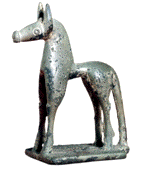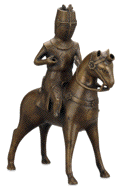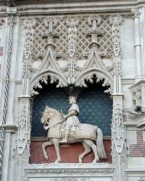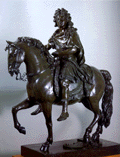
Examples of equestrian art:

Greece, Geometric type, probably made in Sparta about 700 BCE, said to be from Phigaleia (Bassae) in Arcadia, Greece, Figurine of a Horse, bronze, height 4 inches, British Museum, London.

Greece (Tanagra, Boeotia), Horse and Rider, c. 550 BCE, slip decorated terra cotta, British Museum, London. This was a grave offering.

England, late 13th century CE, Bronze Aquamanile, bronze, height 33.0 cm, British Museum, London. See aquamanile.

Qian Xuan (Chinese), Young nobleman on horseback, Yuan dynasty, 27th year of Zhiyuan (1290 CE), handscroll painting, 29.7 x 75.6 cm, British Museum, London.

Antonio Pollaiuolo (Italian, Florence, 1431/32-1498),
Study for an Equestrian Monument, c.
1482-1483, pen and brown ink,
light and dark brown wash;
outlines of the horse and rider pricked for transfer, 11 1/8
x 10 inches (28.1 x 25.4 cm), Metropolitan Museum of Art, NY.
See monument
and transferal.

French, Castle at Blois, an equestrian
statue of King Louis XII in a facade built in the flamboyant
Gothic style, c. 1500. See flamboyant.

Bernard van Orley (Flemish, c. 1488 or 1491/92
- 1542), Otto, Count of Nassau and his Wife Adelheid van
Vianen, 1530-35, pen and brown ink,
watercolor
over traces of black chalk;
verso: tracing
in black chalk of the figures
on the recto, 14 x 19 inches
(35.6 x 48.3 cm), Metropolitan Museum of Art, NY. This is one
of eight tapestry designs commissioned by Henry III of Nassau, an advisor to Emperor
Charles V, about 152830. Unfortunately, the tapestries are
lost, probably destroyed in a fire in 1760.

Francois Girardon (French, 1628-1715), Model for the Equestrian Statue of Louis XIV,
bronze, Hermitage Museum, St.
Petersburg, Russia. See model.

John Ferneley I (English, 1782-1860), Sir Robert Leighton after Coursing, with a Groom
and a Couple of Greyhounds, 1816, oil
on canvas, 105.1 x 139.7
cm, Tate Gallery, London.

John Ferneley I, Major Healey, Wearing Raby Hunt Uniform, Riding
with the Sedgefield Hunt, c. 1833, oil
on canvas, 76.4 x 97.0
cm, Tate Gallery, London.

John Ferneley I, John Burgess of Clipstone, Nottinghamshire, on
a Favourite Horse, with his Harriers, 1838, oil
on canvas, 95.9 x 139.7
cm, Tate Gallery, London.

John Frederick Herring (English, 1795-1865),
Mazeppa Pursued by Wolves (after Horace Vernet),
1833, oil on canvas,
55.9 x 76.2 cm, Tate Gallery, London.
Frederic Remington (American, 1861-1909), The Bronco Buster, 1895, bronze, Columbia Art Museum, SC.

Marino Marini (Italian, 1901-1980), Horseman, 1947, bronze,
163.8 x 154.9 x 67.3 cm, Tate Gallery, London.

Marino Marini, Rider, 1948, drawing and pastel
on paper, 45.4 x 34.0 cm, Tate
Gallery, London.
Also see animalia, bestiary, equine art or equine statue, gyo, gyotaku, and statue.
https://inform.quest/_art
Copyright © 1996-![]()